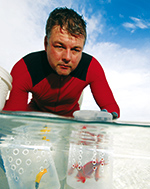Coral has been collected on a commercial basis on the Great Barrier Reef since the 1950s. For the majority of that period, the fishery mostly targeted abundant, fast growing species, such as those from the Acroporidae and Pocilloporidae families, for ornamental display and the curio trade.
In 2006, the Policy for the Management of the Coral Fishery was implemented and the fishery was approved for export eligibility for the first time.
The arrangements reflected the shift in market demand to live corals for mini-reef display. The policy featured a move away from ‘coral leases’ to a roving policy that enabled businesses to distribute and rotate fishing effort across the fishery area to access a diverse range of species and to minimise the risk of localised concentration of effort.
Entry to the fishery has been limited since 1997 and the fishery is operated by fewer than 20 businesses of disparate scale. Many of those businesses also hold licenses in the Marine Aquarium Fish Fishery.
In practical terms, the fishery operates within the Great Barrier Reef Marine Park with two spatially defined high-use Coral Collection Areas at Cairns and around the Keppel group of islands. There is also a hub of collection activity around Mackay.
The emphasis of coral collection is on quality, with specimens chosen for their vibrant colour, appropriate size and suitability for aquaria. There is no market for live corals that are broken, bleached or affected by sediment from flooding.
Much of the coral is sourced from depths greater than 10m and often in areas between reefs. Light levels in these habitats can be more easily replicated in domestic aquaria.
An annual Total Allowable Catch of 200t applies whereby 30% (60t) may be collected as ‘specialty coral’, which comprises living coral specimens. The balance may be collected as ‘other coral’, which mostly comprises live rock with some collection of the fast-growing and abundant species of Acropora spp. and Pocillopora spp. for ornamental purposes.
A system of Individual Transferable Quota applies and is monitored through a system that obliges collectors to report the catch electronically or by phone prior to landing. In 2011–12, 76t of coral was collected in the fishery, including 28t of live coral and 48t of other coral, which comprised 42t of live rock and 6t of ornamental coral.
There are limits imposed on the size of boats and the number of divers. Collectors typically use underwater breathing apparatus, such as SCUBA or Hookah, and collect coral by hand with non-mechanical, hand-held instruments. There is no bycatch in the fishery.
As most corals collected in the Queensland Coral Fishery are listed on Appendix II of CITES, the obligatory Non-detriment Finding plays an important role in the cycle of assessment, management and monitoring of the fishery.




